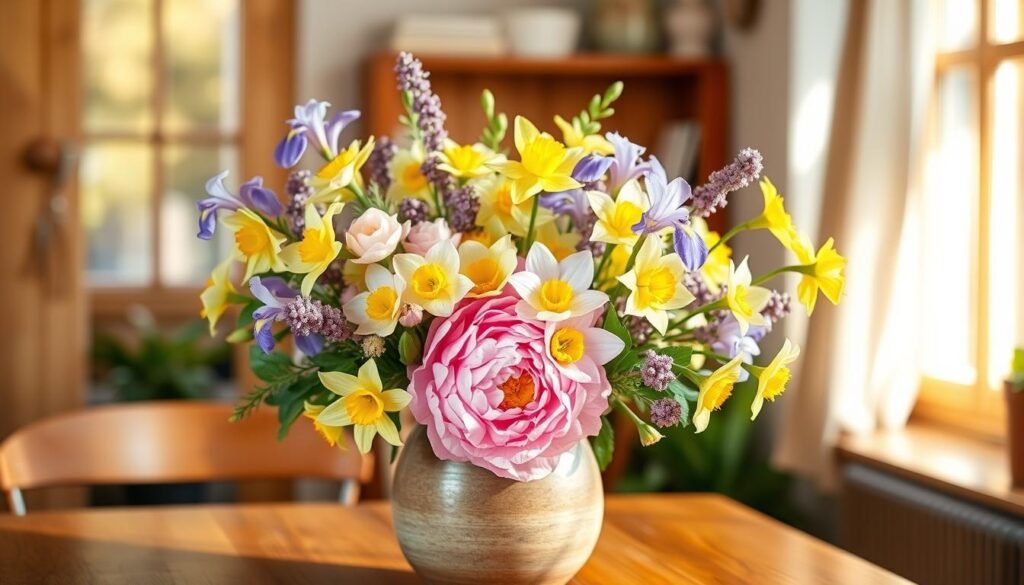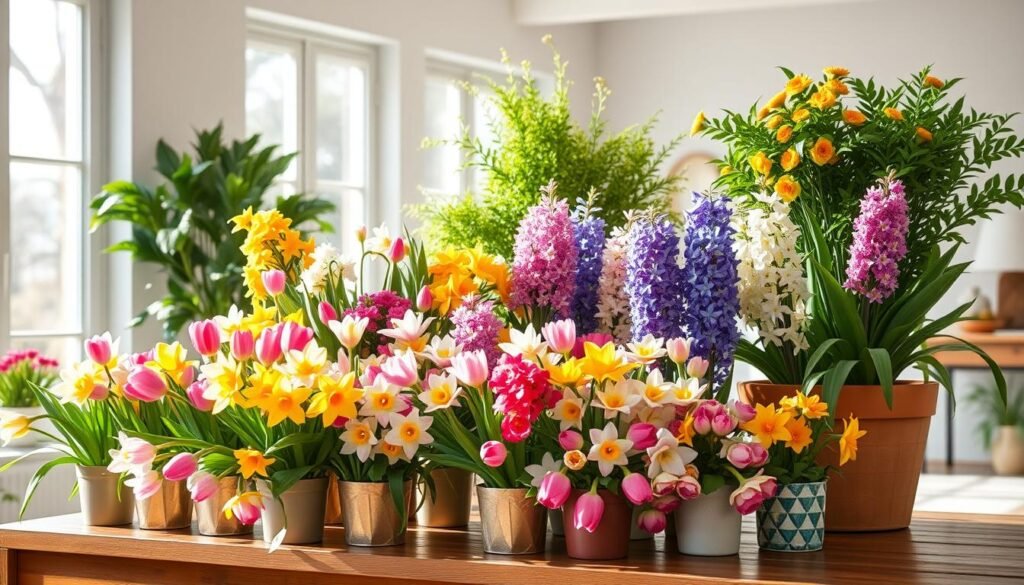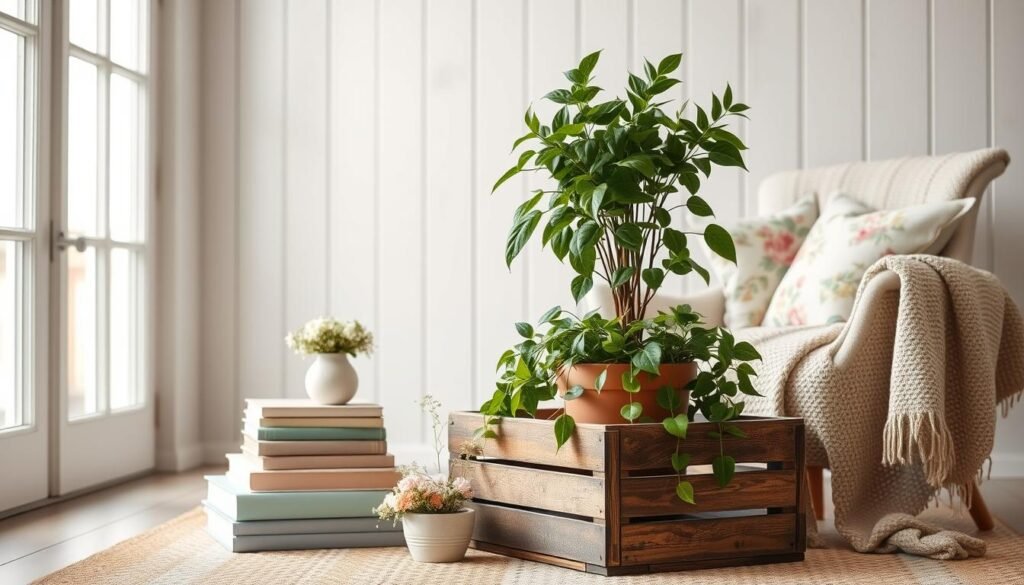Table of Contents
As the days grow longer and nature comes alive, it’s the perfect time to refresh your living space. A few simple updates can transform your home into a vibrant retreat. Light textiles, fresh florals, and natural accents effortlessly capture the essence of the season.
Whether you love bold colors or prefer neutral tones, there’s something for everyone. Think tulips in mason jars, airy curtains, or a DIY wreath made with forsythia branches. Small touches make a big impact without breaking the bank.
1. Hang a Fresh Spring Wreath on Your Front Door
Your front door sets the tone for your home’s seasonal transformation. A handmade wreath symbolizes winter’s end and welcomes warmer days with texture and color. Whether you forage branches or shop at stores like Trader Joe’s, this project blends nature and creativity.

DIY Forsythia Wreath Tutorial
Gather preserved moss, floral wire, and pruning shears for this 45-minute project. Start by wrapping forsythia branches around a grapevine base—Michaels carries sturdy options. Secure stems with hot glue, leaving space for twig nests or faux eucalyptus.
Pro tip: Weave LED fairy lights through the branches for evening charm. UV-resistant stems (52% of options at craft stores) keep colors vibrant outdoors.
Choosing the Right Base for Your Wreath
Not all wreath frames work equally well. Straw bases are lightweight but less durable, while foam suits artificial florals. Grapevine offers a rustic look and holds natural stems securely.
Pair your wreath with bougainvillea topiaries or store it in a breathable bag post-season. Terrain’s quince branches add drama when forced indoors—just soak them in warm water first.
2. Refresh Your Space with Spring Cleaning and Organizing
A clutter-free home is the perfect canvas for seasonal updates. Start with a deep clean to make every new accent shine brighter. Focus on high-traffic zones like entryways and kitchens first.

30-Minute Daily Cleaning Routine
Method’s pink grapefruit cleaner tackles sticky surfaces fast. Split tasks into five 3-minute bursts: wipe counters, vacuum rugs, dust shelves, scrub sinks, and mop floors. Add upbeat music to power through chores.
Decluttering in Just 15 Minutes a Day
Dollar store baskets transform linen closets instantly. Label shelves for towels, sheets, and extras. Donate unused items weekly—60 hours a year adds up to a tidier space.
Pro tip: Baking soda paste removes fridge odors. For musty corners, try cedar sachets or an essential oil diffuser. A clean home boosts mood and productivity all season long.
3. Bring Spring Florals Indoors for Instant Cheer
Nothing lifts your mood faster than a vibrant bouquet on the dining table. Whether you prefer fresh blooms or low-maintenance faux flowers, a floral touch adds warmth to any space.

Best Grocery Store Blooms for Your Home
Trader Joe’s $5.99 tulip bunches and Whole Foods’ orchids (with a guarantee!) are wallet-friendly stars. For longevity:
- Alstroemeria: Lasts 2+ weeks; perfect for busy homes.
- Carnations: Budget-friendly and hardy.
- Daisies: Brighten kitchens for 10+ days.
*Pro tip*: Shop on Wednesday mornings for the freshest blooms.
Mixing Real and Faux Flowers for Long-Lasting Beauty
Pair Pottery Barn’s machine-washable peonies with real asparagus fern for texture. Follow the 80/20 rule: 80% faux as the focal point, 20% fresh stems for realism.
Affordable faux stems under $15:
- Target’s eucalyptus garlands
- Hobby Lobby’s hydrangeas (wait for 50% off sales)
Drop a copper penny in vases to keep water clear—no floral foam needed!
4. Embrace the Charm of Tulips in Every Room
Few flowers transform a room as instantly as tulips in full bloom. Their stems continue growing even after cutting, creating dynamic displays that evolve daily. From Trader Joe’s rare black varieties to Netherlands’ color-grown hybrids, these blooms offer endless decor possibilities.

White Tulips for Neutral Elegance
White tulips bring calm to busy spaces. Pair them with silver dollar eucalyptus for texture. Pro tip: Cut stems at a 45-degree angle for curved arrangements that mimic their natural growth.
Vibrant Orange Tulips for a Pop of Color
Orange tulips energize kitchens or workspaces. Combine with ranunculus for a polished look. Avoid placing them near daffodils—their sap shortens tulip lifespan.
Extend bloom time: Use Floralife Quick Dip preservative or refrigerate buds overnight. For Dutch flair, display them in a tulipiere vessel. Mix parrot tulips (frilly edges) with French doubles (peony-like) for contrast.
5. Create Stunning Potted Spring Flower Displays
Transform grocery store finds into eye-catching centerpieces with these simple tricks. Potted arrangements add vibrant *textures* to shelves, windowsills, or your dining table—no green thumb required. Start with healthy plants and a few clever upgrades.

Repotting Grocery Store Blooms
Store-bought plants often come in cramped containers. Upgrade them with Miracle-Gro Moisture Control potting mix for better growth. Pro tip: Use wine corks at the pot’s base for drainage—no rocks needed.
Pet-safe picks for worry-free styling:
- African violets (thrives in indirect light)
- Orchids (long-lasting and elegant)
- Spider plants (safe for curious pets)
Using Decorative Moss for a Finished Look
Hide plastic pots with sheet moss or sphagnum for a natural *look*. Compare options below:
| Type | Best For | Lifespan |
|---|---|---|
| Sheet moss | Smooth surfaces, terrariums | 2–3 months |
| Sphagnum moss | Moisture retention, orchids | 4–6 months |
Try “moss monograms” by shaping initials with wire and moss for personalized planters. For IKEA SOCKER pots, line the rim with preserved moss for a greenhouse vibe.
Quick fixes: Seal terracotta with beeswax to prevent water stains. Rotate forced bulbs weekly for even growth. A cachepot (decorative outer pot) hides unattractive plastic containers instantly.
6. Force Blooming Branches for a Dramatic Touch
Watching bare branches burst into bloom indoors is one of nature’s most magical transformations. This technique called “forcing” tricks woody stems into flowering weeks early, bringing life to your space before the outdoor season begins. All you need are pruners, water, and a little patience.

Forcing Forsythia and Quince Like a Pro
Smith & Hawken pruning shears make clean cuts essential for successful forcing. Look for branches with swollen buds—these hold the most potential. Forsythia typically blooms in 1-2 weeks, while quince may take 3-4.
Try these water additives to extend bloom time:
- Vodka: 1 tsp per quart prevents bacterial growth
- Bleach: ¼ tsp keeps water clear (avoid with metal vases)
- Aspirin: Crush one tablet to mimic commercial flower food
Pro tip: Hammer thick stems gently to increase water absorption. Change water every 3 days and mist buds to prevent drying.
Sourcing the Best Branches
Brooklyn Grange flower market offers premium cuttings during their March pop-ups. For local options, check USDA zone recommendations:
| Zone | Best Branches | Forcing Start Date |
|---|---|---|
| 3-5 | Pussy willow, cherry | February 15 |
| 6-8 | Apple, magnolia | January 25 |
Always ask permission before cutting from public spaces—many parks prohibit foraging. Allergy sufferers should avoid fragrant varieties like lilac.
Preserve special branches by soaking in glycerin solution (1:2 ratio with water) for 4 days. Pair forced stems with driftwood or curly willow for organic texture that lasts all year.
7. Design Beautiful Spring Vignettes Throughout Your Home
Small, curated displays can instantly elevate your living room or entryway. These mini-settings tell a visual story through carefully chosen things. Start with a focal point, then layer complementary pieces around it.

Layering Candles, Books, and Seasonal Accents
The golden triangle rule creates balance in vignettes. Place taller items like Anthropologie’s marble book weights at the back. Medium-height objects (candles, small plants) go in the middle. Front space works for flat items like ribbon-tied books.
Unexpected risers add dimension:
- Vintage dictionaries stacked under a vase
- Cake stands displaying collectible egg cups
- Inverted wooden bowls elevating potted herbs
Creating a Cohesive Story with Your Decor
Pick a theme like “garden tea party” or “birdwatcher’s nook.” Use paint chips to develop a 3-color palette. Mix textures—woven baskets, metallic frames, and ceramic pitchers create depth.
Follow this rotation schedule to keep displays fresh:
| Week | Focus | Example Items |
|---|---|---|
| 1-2 | Early blooms | Forced branches, pastel ribbons |
| 3-4 | Easter elements | Nesting tables, ceramic rabbits |
Leave 30% negative space to avoid clutter. Natural light showcases details best, but warm LEDs work for evening. Photograph from a 45-degree angle for Instagram-worthy shots.
8. Infuse Your Home with the Scents of Spring
The right fragrance can transform your space into a seasonal sanctuary. Unlike visual things, scent creates emotional connections—think lilac bushes from childhood or rain on warm soil. With these techniques, you’ll craft an aromatic home that evolves with the season.
Essential Oil Blends for the Season
Young Living’s Bloom collection offers pre-mixed options, but DIY blends let you customize intensity. Consider these migraine-friendly combinations:
- Calm mornings: 3 drops lavender + 2 drops chamomile
- Energy boost: 4 drops grapefruit + 1 drop peppermint
- Evening unwind: 2 drops bergamot + 3 drops cedarwood
Pro tip: Reed diffusers work best in bathrooms (70% humidity extends life), while nebulizers suit large living rooms. Avoid eucalyptus and tea tree oils if you have pets.
DIY Spring Simmer Pot Recipes
Williams Sonoma’s ceramic pots make stovetop simmering stylish. Try these 3-step combos:
- Base: 2 cups water + 1 tbsp vanilla extract
- Add fresh citrus slices (lemons last longest)
- Botanical accents: rosemary sprigs or rose petals
For safety, always use stainless steel pans—enamel can crack. Refresh sachets monthly with dried orange peels. Add fresh herbs like mint when guests arrive for instant impact.
| Method | Duration | Best For |
|---|---|---|
| Simmer pots | 2-3 hours | Open-concept spaces |
| Linen sprays | 1 week | Bedrooms/closets |
“Scent zoning—different aromas per room—helps transition between activities. I use lavender in my office and vanilla in the kitchen.”